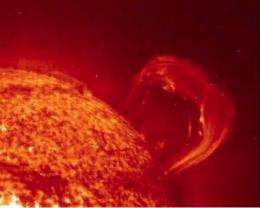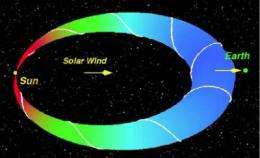Scientists unlock the secrets of exploding plasma clouds on the sun

Twisted "ropes" of magnetic field lines erupt from the Sun and tanglewith the Earth's magnetic field.
The Sun sporadically expels trillions of tons of million-degree hydrogen gas in explosions called coronal mass ejections (CMEs). Such clouds -- an example is shown in Figure 1 -- are enormous in size (spanning millions of miles) and are made up of magnetized plasma gases, so hot that hydrogen atoms are ionized. CMEs are rapidly accelerated by magnetic forces to speeds of hundreds of kilometers per second to upwards of 2,000 kilometers per second in several tens of minutes. CMEs are closely related to solar flares and, when they impinge on the Earth, can trigger spectacular auroral displays. They also induce strong electric currents in the Earth's plasma atmosphere (i.e., the magnetosphere and ionosphere), leading to outages in telecommunications and GPS systems and even the collapse of electric power grids if the disturbances are very severe.
Since the first observation of a solar flare in 1859, solar eruptions ("explosions") have attracted much attention from scientists around the world and have been studied with a succession of increasingly sophisticated international satellite missions in the past three decades. A major challenge has been that enormous and complicated plasma structures accelerating away from the Sun can only be observed remotely. As a result, it has been difficult to test theoretical models to establish a correct understanding of the mechanisms that cause such eruptions. But in 2006, an international twin-satellite mission called STEREO was launched to continuously observe the erupting plasma structures from the Sun to the Earth.

Now, using the data from STEREO, new research by scientists at the Naval Research Laboratory (NRL) in Washington, D.C., demonstrates for the first time that the observed motion of erupting plasma clouds driven by magnetic forces can be correctly explained by a theoretical model. The work will be presented at the 52nd Annual Meeting of the APS Plasma Physics Division.
The theory, controversial when it was first proposed in 1989 by Dr. James Chen of NRL, is based on the concept that an erupting plasma cloud is a giant "magnetic flux rope," a rope of "twisted" magnetic field lines shaped like a partial donut. Chen and Valbona Kunkel, a doctoral student at George Mason University, have applied this model to the new STEREO data of CMEs and shown that the theoretical solutions agree with the measured trajectories of the ejected clouds within the entire field of view from the Sun to the Earth.
The position of the leading edge (LE) of a CME that erupted on December 24, 2007 were tracked by the STEREO-A spacecraft from the earliest stages of eruption to its arrival at 1 AU approximately five days later. The magnetic field and plasma parameters were measured by the STEREO-B spacecraft. The agreement between theory and data is within 1 percent of the measured position of the LE. Chen and Kunkel's results show that the theoretically predicted magnetic field and plasma properties are in excellent agreement with the measurements aboard STEREO-B. This is the first model that can replicate directly observed quantities near the Sun and the Earth as well as the actual trajectories of CMEs. Prior to STEREO, the motion of CMEs in the region corresponding to HI1 and HI2 data was not observed.
Interestingly, the basic forces acting on solar flux ropes are the same as those in laboratory plasma structures such as tokamaks developed to produce controlled fusion energy. The mechanism described by the theory is also potentially applicable to eruptions on other stars.
Provided by American Physical Society



















